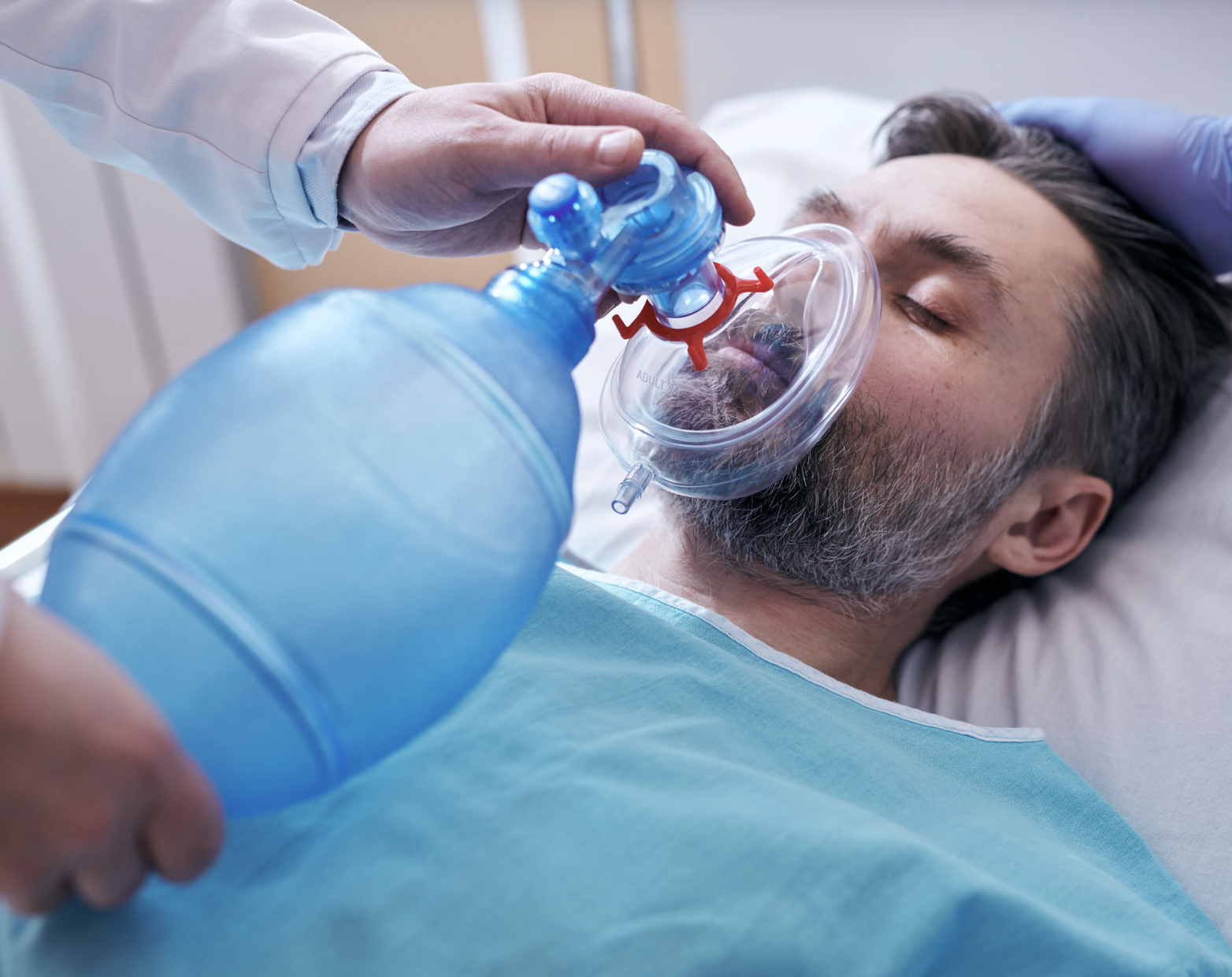
It's Clear, Ventilation Improves Outcomes!

Common solutions—like using small adult manual resuscitators—have led to severe underventilation and worse patient outcomes3,9.
The Problem
The Problem: High Variability in Performance

Manual ventilation is the standard means of providing emergency ventilatory support. Despite its wide-spread use, it remains a skill with high variability regardless of a healthcare provider’s qualifications, training, experience, or confidence.
This may be attributable to inherent challenges in an emergency situation, coupled with the minimal safeguards available with manual resuscitator. Such variability can lead to hyperventilation, including overventilation, and/or hypoventilation, including underventilation, each carrying risks of severe complications such as aspiration pneumonia, lung injury, Acute Respiratory Distress Syndrome (ARDS) and even death.
98%
Of responders delivered at least one breath that was inadequate or excessive per 90-second period.8
Providers use a manual resuscitator only 1-2 times per year, making skill retention a challenge.
The Solution: Integrated Training & Clinical Solution
Our Supporters







Awarded a Technology/Therapeutic Development Grant as a part of the Military Medical Research and Development program by the Department of Defense (DoD)

Awarded 2 grants by the NIH, one Phase II SBIR/STTR grant, and one grant in collaboration with UMASS Memorial Medical Center

Awarded Phae I SBIR contract by the AFWERX/AF Ventures initiative of the US Air Force

Awarded Phase I & II SBIR/STTR grants by the National Science Foundation

Sotair (1st & 2nd gen) was selected as a winner in 2019 and 2022 for the EMSWORLD Innovation Awards

Selected in 2020's International Top 20 (out of 1800)

Out of 130 companies, SafeBVM was 1 of 2 companies that were awarded grants

Won Gold Prize in the 2019 European Design Awards

Awarded a small business grant for the development and commercialization of SafeBVM's technology

Selected for the 2021 program focused on companies looking to improve care, reduce costs and create new efficient approaches to problems within the medical industry

Selected into the highly competitive NASDAQ Milestone Makers Program

Won 1st place at the University of Minnesota's 2019 Design of Medical Device Conference

Sotair was published as a potential solution to reduce barotrauma, overventilation, and underventilation in periods of extended manual ventilation
Testimonials
safeBVM’s device does limit pressure delivered and can be utilized with monitoring devices if needed. This inexpensive accessory to manual ventilation is a must at reducing harmful pressure during emergency care in and out of the hospital. Once approved, this device will be a tool that Respiratory Therapists (RTs) around the world will utilize to provide a safe means for resuscitation. I look forward to a successful collaboration that can assist in making manual ventilation safer in the future
Joe Holley,MD FACEP FAEMSMedical Director of the State of Tennessee EMS,
Associate Professor in Emergency Medicine at University of Tennessee Health Science Center

safeBVM’s device does limit pressure delivered and can be utilized with monitoring devices if needed. This inexpensive accessory to manual ventilation is a must at reducing harmful pressure during emergency care in and out of the hospital. Once approved, this device will be a tool that Respiratory Therapists (RTs) around the world will utilize to provide a safe means for resuscitation
Douglas S. Gardenhire,EdD, RRT-NPS, FAARCChairman, Department of Respiratory Therapy,
Georgia State University

Previous
Next
Recent Blogs
SafeBVM & Sotair/SotairIQ: Aligned with 2025 AHA Guidelines
Reference: 2025 American Heart Association Guidelines for CPR and ECCVentilation Fundamentals 2025 AHA Guidelines: Recommend delivering each breath over one...
Read MoreSotairIQ Named 2025 EMS World Innovation Award Finalist
SafeBVM’s SotairIQ training platform has been named a 2025 EMS World Innovation Award finalist, continuing a track record of recognition...
Read MoreSafeBVM’s CAPCE-Accredited Workshop Featured in EMS World
We’re excited to share that the SafeBVM manual ventilation workshop, a CAPCE-accredited training program, was recently featured in EMS World....
Read MoreAlveolar Hypoventilation: In-Depth Clinical Perspectives from Dr. Arthur Slutsky
Alveolar hypoventilation is about CO₂ retention, not just low oxygen. This blog explains its physiology, causes, and treatment — highlighting...
Read MoreNon-Invasive Ventilation: In-Depth Clinical Perspectives from Dr. Arthur Slutsky
Non-invasive ventilation (NIV) delivers life-saving positive pressure support without intubation. Backed by strong evidence in COPD and cardiogenic pulmonary edema,...
Read MoreAirway Management: In-Depth ClinicalPerspectives from Dr. Arthur Slutsky
Dr. Arthur Slutsky is a world-renowned physician-scientist whose career bridges biomedical engineering, critical care medicine, and mechanical ventilation research. Positions:...
Read MoreMechanical Ventilation: In-Depth Clinical Perspectives from Dr. Arthur Slutsky
Dr. Arthur Slutsky is one of the world’s most recognized experts in respiratory mechanics, critical care, and mechanical ventilation. His...
Read MorePositive Pressure Ventilation: Clinical Reflections from Dr. Arthur Slutsky
Dr. Arthur Slutsky is one of the world’s most recognized experts in respiratory mechanics, critical care, and mechanical ventilation. His...
Read MoreBag-Valve-Mask Ventilation: Expert Tips from Dr. Slutsky
Dr. Arthur Slutsky is a world-renowned physician-scientist whose career bridges biomedical engineering, critical care medicine, and mechanical ventilation research. Positions:...
Read MoreSafeBVM will be exhibiting at the Texas EMS Conference in Austin, TX, November 21-22nd, 2022
SafeBVM will be exhibiting at the Texas EMS Conference in Austin, TX, November 21-22nd, 2022. Come see us at booth...
Read MoreSafeBVM’s ADULT Sotair Device Named a Finalist in EMS World Expo Innovation Awards
EMS World is proud to present the finalists for the 2022 EMS World Innovation Awards. The Innovation Awards program recognizes...
Read MoreThe ADULT Sotair Device Receives 510 (k) clearance
SafeBVM’s first product, the ADULT Sotair™ Device, was recently FDA 510(k) cleared and will be available for purchase at the...
Read More